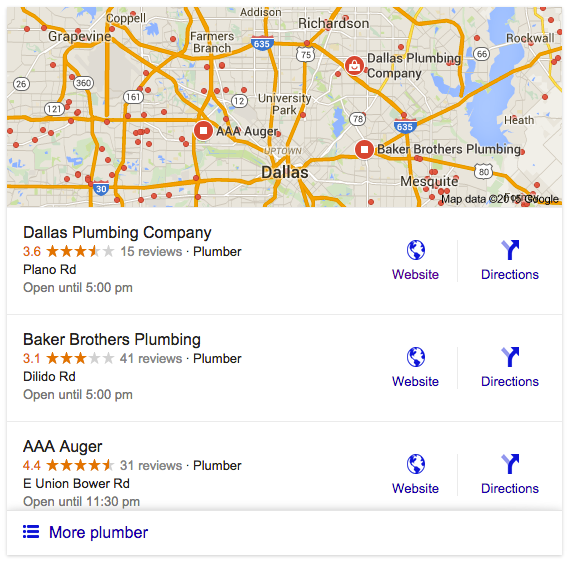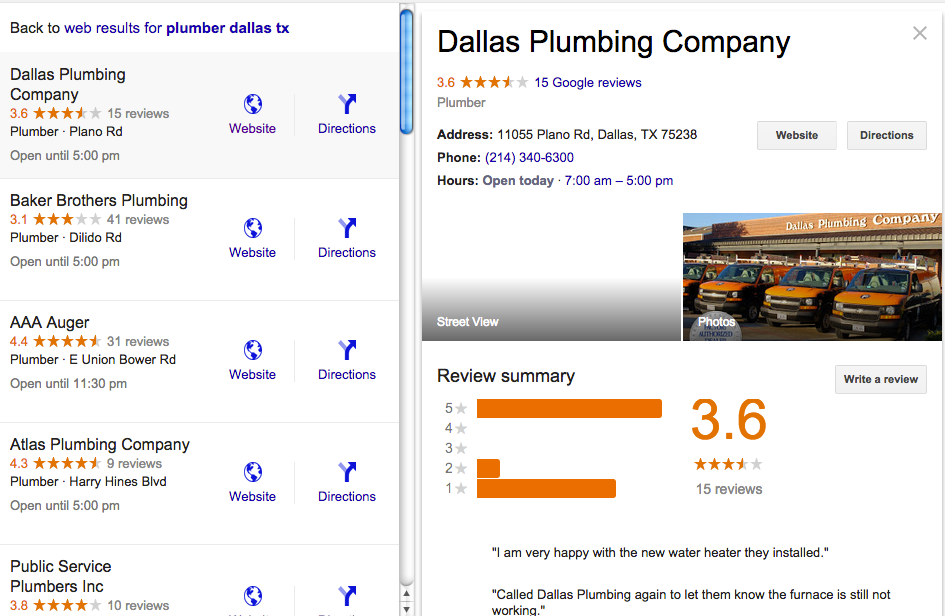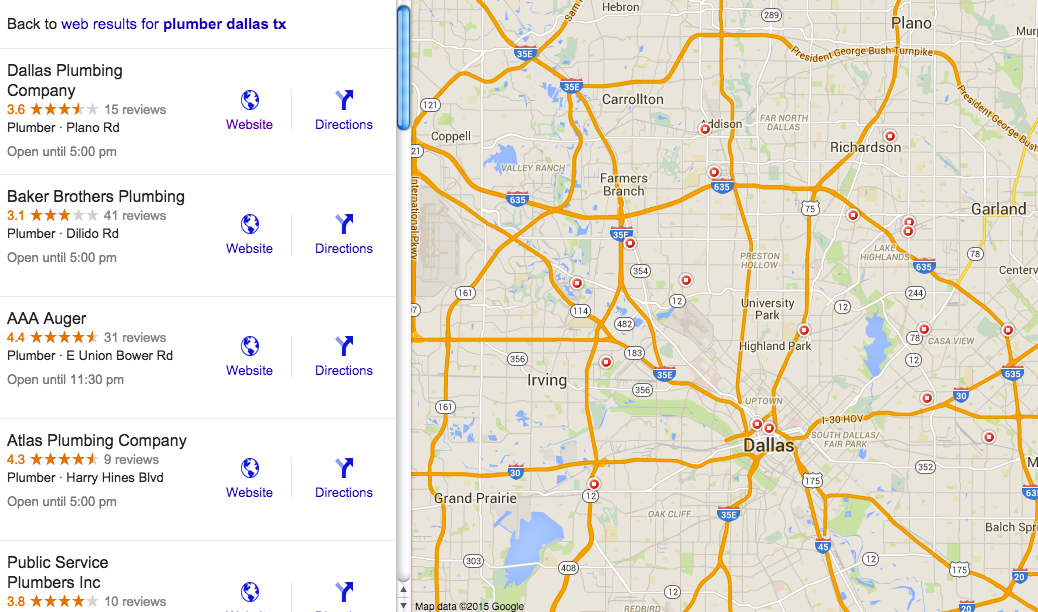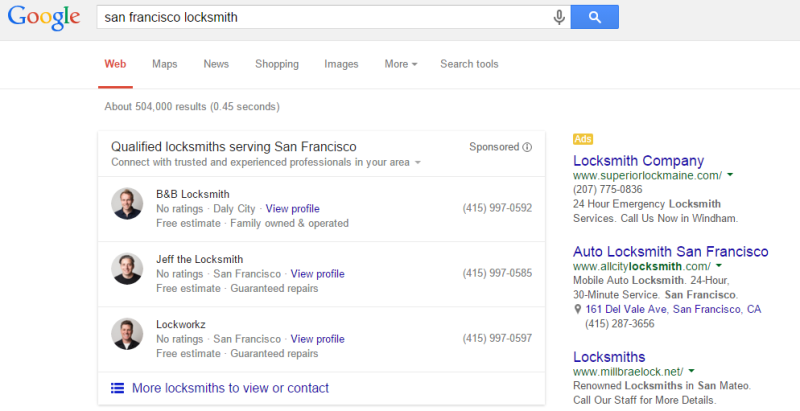Editor’s Note: This article was originally published by Web Marketing Today. Practical Ecommerce acquired Web Marketing Today in 2012. In 2016, we merged the two sites, leaving Practical Ecommerce as the successor.
Google just made a series of updates that have bearing on how well local businesses appear in search results. Here’s a rundown of the changes and how they could affect your ranking.
Local ‘7-Pack’ Now ‘3-Pack’
When users conducted a search with local intent, Google used to return what was called a “7-pack,” which appeared near the top of the results and displayed seven local businesses ordered algorithmically by a combination of the number of reviews and distance from the searcher’s location.

An example of Google 7-pack, now discontinued.
The 7-pack has now been replaced by a smaller, more simplified version — the “3-pack” (or what some are referring to as the “Snak Pak”) — that has, ostensibly, been redesigned to accommodate mobile search.

Local 3-pack return for Dallas plumbers.
Information contained in 3-pack listings include:
- The business name;
- A summary of customer reviews;
- Business category and general location;
- How long the business will be open on a given day (e.g., Open until 5:00 p.m.);
- A link to the company website;
- A link to directions, which opens to Google Maps.
Missing is any reference to Google Plus.
Clicks Display ‘Local Finder’
In the previous iteration, clicking on any of the businesses listed in the 7-pack opened the Knowledge Graph — a panel that contained more information about the business — in the right-hand column of the search page.
Now, clicking on a listing in the 3-pack takes the searcher to what some have termed a “Local Finder,” which opens on a separate page.

Local Finder replaces the front-page Knowledge Graph.
Two columns comprise the Local Finder. The left-hand column shows a horizontal style carousel displaying 20 results. The right-hand column presents a window resembling the Knowledge Graph. It contains the NAP (name, address, phone number), a link to the company’s website, directions, a review summary, a list of Google reviews, and a link to write a review.
A click on the “More” link, located at the bottom of the 3-pack, also opens the local finder. But instead of the Knowledge Graph, a Google Map appears showing the location of the businesses listed in the carousel.

Clicking the “More” link brings up Google Maps.
Local Search Reviews
Google seems to be emphasizing the use of customer reviews. However, reviews no longer link directly to Google Plus business pages, but appear in a window of their own. (More on reviews later.)

Reviews no longer direct to Google Plus, but appear in their own window.
Experimenting with Home Services Ads
Google is also experimenting with 3-pack results that include AdWords ads for home services businesses — locksmiths and plumbers specifically.

Google is experimenting with home services business ads in 3-pack.
Currently, these ads only show up in search results for the San Francisco Bay area, but that could change, depending on the experiment’s results. Given that a large portion of Google’s income stems from ads, it would not be a surprise.
Implications for Local Businesses
These changes affect how local businesses appear in search returns in several ways.
Less chance for front-page returns. The reduction from seven results to three means that there is less opportunity for a local company to appear in front-page returns.
Hopefully, searchers will click through to the local Finder to see more results. The lack of a phone number on the 3-pack may encourage such activity, but there is no guarantee that will happen. Searchers could click the website or directions links just as easily.
To compete for 3-pack placement, a business will need to get more reviews, as that seems to be a significant factor.
Google Plus presence eliminated. The disassociation between local search and Google Plus is notable and indicates that Google is back-peddling on the social network’s significance even further.
That’s not to suggest Google Plus no longer plays a role. While references to Google Plus pages are missing entirely, almost all of the information being displayed comes from them. As such, it’s vital that such information be as accurate as possible and that companies emphasize both receiving and responding to customer reviews.
Google also announced that it will shut down any non-verified Google Plus accounts. Businesses that wish to retain their Google Plus page need to claim and verify their listing in Google My Business (GMB), the portal to all things local business-related. (It’s a good idea to do that anyway, whether or not Google Plus continues to survive.)
Organic search is more important than before. These changes necessitate that businesses do a better job of optimizing for organic search. That means having an SEO- and mobile-friendly website, updating the site with fresh, relevant content, and getting listings in local directories based on industry category. Google places a high value on citations as a means of verifying a company’s identity, and reputable directories are one way to get them.
Advertising may be necessary. Given these changes, local businesses may have no choice but to spend part of their marketing budget on advertising. Google AdWords can help get a company on the front page, and if Google’s experiment — mentioned above — works out, it could help them gain a position in the coveted 3-pack.
Steps Local Businesses Should Take
Here are five things you should be doing now to insulate your business against the changes.
- Conduct a search for your business category — including city and state — to see if you appear in either the 3-pack or local finder.
- Claim your listing on Google My Business and populate your Google Plus page with accurate information.
- Encourage and respond to customer reviews.
- Build citations by claiming your business listing in local directories.
- Stimulate organic traffic by getting a search-optimized, mobile-friendly website. Keep it updated with fresh, high-quality content.
Google constantly adjusts its algorithm with the goal of improving the quality of search results. Taking these steps will help protect your website from being subjected to a ranking reduction.


